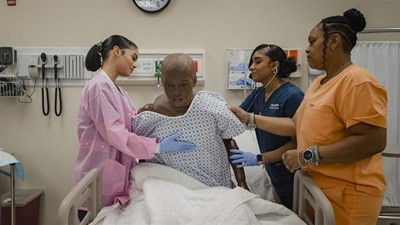Behind the Scenes With Crash Course’s Popular ‘Religions’ Series
A chat with the host and executive producer of the Pew-supported YouTube videos

The YouTube educational channel Crash Course produces video series on a wide range of subjects in the humanities and sciences. With nearly 17 million subscribers, this trusted and popular resource for learners of all kinds has ignited a passion for the humanities in viewers ages 13 to 34.
In 2024, with support from The Pew Charitable Trusts, Crash Course added a religion series designed to strengthen people’s knowledge of different religions and how they can coexist in a religiously diverse society. The 24-part online course introduces viewers to many religious traditions, including some that are lesser known, and explores larger questions around the subject, such as views on the afterlife and religion’s relationship to science. The videos have generated an enthusiastic following, attracting more than 5 million views in the first year, more than double the original goal of 2 million views.
John Green is the host of Crash Course as well as its co-creator, along with his brother Hank Green. Together, they founded Complexly, the production company behind Crash Course that breaks down complicated concepts on a range of topics to reduce barriers to knowledge building. Green is also the author of bestselling novels and nonfiction books, including The Fault in Our Stars and Everything Is Tuberculosis. As interim executive producer, Meghan Modafferi led a team of writers, editors, and subject matter experts to develop the religion series’ curriculum, teaching strategies, and scripts.
Together they explain what went into creating the religion series and why they think it’s become so popular.
John, why was it important to you to host this course?
Green: As a college freshman, I found myself in a religious studies classroom largely by accident: It happened to fit in with my priorities of sleeping in as late as possible. But my professor, Dr. Rogan, said something that first day that stuck with me. Whether you’re religious or not, you worship: You worship a band, or you worship an economic ideology, or you worship a system of ethics, or whatever else. And understanding what you worship and why and how that worship shapes you is an important endeavor—not just for individuals, but for societies.
I ended up majoring in religion, spending some intense time in my early 20s as a chaplain, and writing about religion often in the years that followed. I’ve stayed interested in what and why and how we all worship, and I wanted to host this series to explore those questions with the Crash Course community.
According to Pew Research Center, 44% of young adults ages 18 to 29 identify as “religiously unaffiliated”—yet many of your viewers are within this age bracket. Why do you think this generation is showing interest in religion as you’ve presented it?
Modafferi: The series explores religion as it intersects with just about everything else: culture, politics, history, science, and the everyday aspects of people’s lives. Just because young people aren’t as religiously affiliated as in previous generations doesn’t mean they’re any less interested in the big questions about morality, the afterlife, and how to live together in a community. It stands to reason that they might actually be more curious because of religion’s diminished status as a traditional source of authority.
Perhaps that very shift is what’s leading them to look elsewhere for answers to existential questions. We’re so proud that young people are turning to Crash Course to learn more about different cultures and historical perspectives and to better understand the world’s complexity.
Religious literacy courses are often organized around the world’s largest religions, “the big five”: Christianity, Islam, Judaism, Buddhism, and Hinduism. You talk about many more than these, and even explore the difference between religions, cults, and magic. Why was this important?
Modafferi: When recruiting religious scholars, we quickly learned how fraught the idea of “the big five” is in the field today. Which religions are seen as “major” versus “minor” isn’t as straightforward as which are practiced by the most people—which is what I would have assumed. It turns out much of the work of the religious studies field today is focused on deconstructing deceptively simple ideas about history, religion, culture, and how we categorize it all. (There’s lots more on this in series episodes 1 and 2.)
What do you hope viewers will take away from the series?
Modafferi: It would be great if people leave the series with more questions than answers. I hope the series offers frameworks for personal reflection in viewers’ own lives about what brings them meaning, community, and connection. At the same time, I hope the series provides a broader lens on society, helping viewers think in a more nuanced way about history, culture, and current events.
Green: I hope people will take away an ongoing curiosity about other people’s worldviews, ways of telling stories, and ways of joining together in community. Whenever we can, we try to replace things like distrust or despair with curiosity and awe.
The series doesn’t talk much about religious prejudice—the lack of understanding and tolerance for different religions. Why not?
Modafferi: Religious prejudice is a theme that pops up across many episodes—like Religion and Race, Religious Freedom, and Indigenous Religions—but we didn’t devote an entire episode to it because it’s so diverse. It’s not as simple as people being merely unkind. It’s tied up in the definitions we hold about what religions are—and aren’t—what counts as a “major” religion, who is allowed to speak on a religion’s behalf, and so on.
We felt those topics were better tackled in specific contexts rather than in a zoomed-out way.
How did you strike the “right” balance between facts and fun, while keeping the content concise?
Modafferi: It wasn’t easy. We focused on finding one or two specific stories to drive each episode and help make abstract ideas concrete and engaging. We also worked hard to break up heavier sections with jokes and personal reflections from John. Our scripting process has multiple phases: We start by defining the learning objectives and examples and then later have specific rounds that are focused on adding humor and fun.
Green: The devil’s advocate character helped a lot. The team developed him as a device to debunk common misconceptions in a playful rather than preachy way. It was funny to imagine things like, what would this guy wear? Definitely a tracksuit. We poke fun at him throughout the series, but ultimately, he’s relatable too. We’ve all had moments where we don’t realize our blind spots or the limits of our perspective.
How did you tackle the complexities, nuances, and potential sensitivities of religion as a topic when developing this series?
Modafferi: We worked with many different religious scholars who specialize in diverse areas to review and give feedback on sensitive topics. In many cases, we brought in multiple experts to review a single episode from a variety of perspectives to ensure we were being fair and balanced with respect to the different groups represented.
Is there anything else you’d like our readers to know?
Modafferi: Perhaps the biggest lesson we learned from this series is that religion isn’t separate from the rest of life. The stories we tell, the ideas we absorb, the meanings we make—they’re all woven together not just with our geopolitics broadly but within our everyday lives and relationships. And the more we understand that, the more we can live in peaceful community with one another.
Green: It’s hard to remember sometimes because we’re all stuck inside our own heads, but other people are as real as you are. Their inner lives are as active and rich as your own. Series like this help us remember both the diversity of the human experience and what we all have in common.
Visit the Crash Course Religions website to learn more and watch the series.









